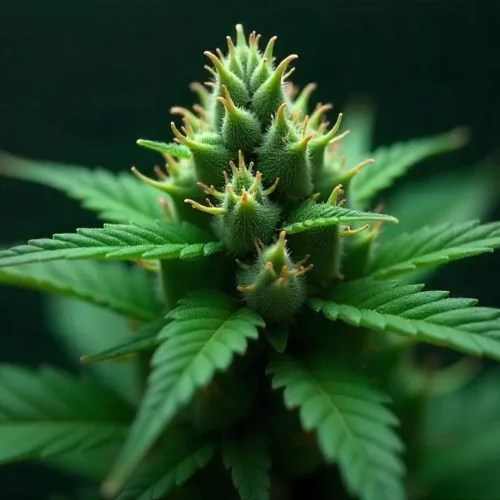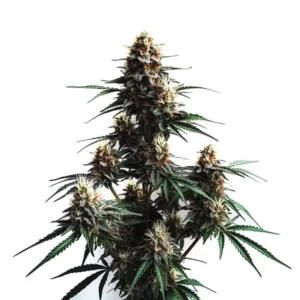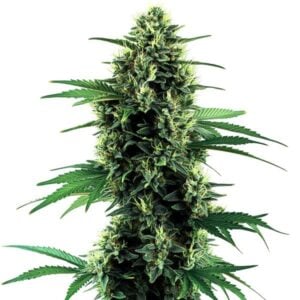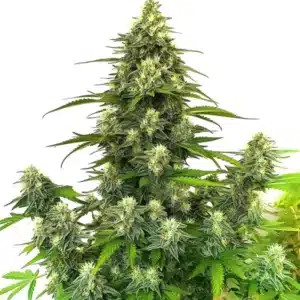Hindu Kush Autoflowering Description
Hindu Kush Auto is a celebrated cannabis strain derived from the classic Hindu Kush genetics, combined with Star Dawg and Ruderalis to create a potent autoflowering hybrid. This mostly Indica strain is recognized for its remarkable combination of resilience, flavor, and effects, making it a favorite among both novice and seasoned cultivators.
The buds of Hindu Kush Autoflowering are dense, compact, and heavily coated with sparkling trichomes, showcasing its high THC content. Its aroma is equally impressive, offering a rich combination of earthy, pine, and woody notes, layered with a subtle sweetness that adds complexity to its flavor profile.
Recommended Strains
Hindu Kush Autoflower
 THC: 22% - 24%
THC: 22% - 24% Type of seed: Autoflowering
Type of seed: Autoflowering Phenotype: Mostly Indica
Phenotype: Mostly Indica Day to flower: 7 - 9 weeks
Day to flower: 7 - 9 weeks
Hindu Kush
 THC: 15% - 19%
THC: 15% - 19% Type of seed: Feminized
Type of seed: Feminized Phenotype: Mostly Indica
Phenotype: Mostly Indica Day to flower: 8 - 10 weeks
Day to flower: 8 - 10 weeks
With THC levels ranging from 22% to 24%, Hindu Kush Autoflowering delivers a balanced yet powerful experience. The effects are uplifting and creative, transitioning into a relaxing body high that soothes the mind and body. This makes it an excellent choice for unwinding after a long day or for use during moments of creative inspiration. The Hindu Kush flowering time is relatively quick, making it an attractive option for growers seeking efficiency. Medically, it is widely valued for its effectiveness in alleviating symptoms of arthritis, chronic pain, and insomnia.
Promos & Deals
Environmental Requirements for Growing Hindu Kush Autoflowering
Hindu Kush Auto is a robust and versatile strain that adapts well to various environments. However, creating the ideal conditions can significantly improve its growth and yield. Whether growing indoors or outdoors, maintaining a consistent climate is essential.
Indoors, Hindu Kush Autoflowering thrives in a controlled environment where temperatures can be kept between 70-80°F (21-27°C) during the day. Nighttime temperatures should be slightly lower, around 65-70°F (18-21°C). Humidity levels during the vegetative stage should be around 50-60%, while in the flowering phase, it is best to lower it to 40-50% to prevent mold and mildew.
For outdoor cultivation, this strain performs best in regions with warm and sunny climates. However, it is resilient enough to grow in less favorable conditions, provided it receives adequate sunlight and protection from extreme weather. In cooler climates, a greenhouse setup can extend the growing season and safeguard plants against frost or heavy rain.
Using high-quality LED grow lights indoors is crucial to mimic the sun’s intensity and spectrum. A light cycle of 18-20 hours per day during the vegetative phase is ideal for autoflowering strains like Hindu Kush. Outdoor growers should ensure the plants are placed in a location with maximum sunlight exposure throughout the day.
Setting Up the Cannabis Growing Space
Indoor Cannabis Cultivation
For indoor growers, the first step is to choose an appropriate growing space. This can be a grow tent, a dedicated grow room, or any enclosed area that can be controlled for temperature, humidity, and light. A grow tent is often the preferred choice for its convenience and ease of setup.
Ensure the growing space has adequate ventilation to maintain fresh airflow. Install an exhaust fan and a carbon filter to manage odors and prevent heat buildup. The reflective interior walls of a grow tent maximize light efficiency, ensuring the plants receive even light distribution.
The growing medium plays a crucial role in the plant’s health. Soil mixed with organic compost or a hydroponic setup can be used, depending on the grower’s experience and preferences. If using soil, ensure it is well-draining and rich in nutrients. Maintain a soil pH between 6.0-6.5 for optimal nutrient uptake.
Outdoor Cannabis Cultivation
When growing Hindu Kush Autoflowering outdoors, selecting the right location is critical. Choose a spot that receives direct sunlight for most of the day. The soil should be fertile and well-draining. If the native soil is not ideal, consider using large fabric pots or raised beds filled with a nutrient-rich soil mix.
Outdoor plants can be susceptible to pests and environmental stressors. Using organic pest repellents and physical barriers like mesh screens can help protect the plants. Strong winds can damage the branches, so placing the plants near a fence or using windbreaks is advisable.
To maximize yields, regularly prune the lower branches and leaves that receive minimal light. This improves airflow and ensures the plant directs its energy toward bud production.

Propagation and Germination of Hindu Kush Autoflowering
Successful germination sets the foundation for a healthy crop. Hindu Kush Autoflowering seeds are easy to germinate, making them suitable for growers of all experience levels. Start by sourcing high-quality seeds from a trusted supplier to ensure genetic stability and feminization.
Begin the germination process by soaking the seeds in distilled water for 24-48 hours. This step helps to soften the seed shell, encouraging the emergence of the taproot. Alternatively, you can place the seeds between damp paper towels in a warm, dark environment. Maintain a temperature of 70-85°F (21-29°C) to optimize germination rates.
Once the seeds have sprouted, transfer them into a light, well-draining soil mix or seedling trays. Place the seeds about half an inch deep, ensuring the taproot faces downward. Keep the soil consistently moist but not waterlogged, and maintain a humidity level of 60-70% during this stage.
As the seedlings grow, provide them with gentle, indirect light. A small LED grow light or natural sunlight works well during the first week. Once the plants develop their first set of true leaves, they can be transplanted into larger pots or their final outdoor location.
Vegetative Phase of Hindu Kush Autoflowering
The vegetative phase is when Hindu Kush plant focus on developing strong roots, stems, and foliage. This phase is relatively short for autoflowering strains, as they transition to flowering based on age rather than light cycles.
Provide a consistent light cycle of 18-20 hours per day during this stage. High-quality LED grow lights are ideal for ensuring robust growth. Maintain temperatures around 70-80°F (21-27°C) and humidity levels of 50-60% to support healthy development.
Nutrition is crucial during this phase. Use a fertilizer high in nitrogen to promote vigorous leaf and stem growth. Avoid overfeeding, as nutrient burn can harm the plants. Water the plants only when the top inch of soil feels dry, and ensure proper drainage to prevent root rot.
Training techniques like low-stress training (LST) can be employed to optimize light exposure and prepare the plants for the flowering stage. This involves gently bending and securing the branches to create an even canopy.
Flowering Phase of Hindu Kush Autoflowering
The flowering phase is when Hindu Kush Autoflowering plants develop their signature buds. This stage begins naturally within 7-9 weeks, regardless of light cycles, making it ideal for growers seeking a quick turnaround.
Transition to a bloom-specific nutrient formula with higher phosphorus and potassium levels to support bud development. Keep temperatures slightly cooler, around 65-75°F (18-24°C), and reduce humidity levels to 40-50% to prevent mold and mildew. Provide ample support for the branches as the buds grow denser and heavier.
Monitor the trichomes closely to determine the best harvest time. Trichomes should appear milky with a few turning amber, indicating peak potency and flavor.
Fertilization and Nutrition
Hindu Kush Autoflowering requires a balanced nutrient regimen to thrive. During the vegetative phase, focus on nitrogen-rich fertilizers to support foliage growth. As the plants transition to flowering, switch to a nutrient mix higher in phosphorus and potassium.
Organic amendments like worm castings or bat guano can enhance soil fertility. Supplements such as mycorrhizal fungi improve root health and nutrient uptake. Regularly monitor the plants for signs of nutrient deficiencies or toxicities, and adjust feeding schedules accordingly.
Pest and Disease Control
Although Hindu Kush Auto is resilient, it is not immune to pests and diseases. Preventive measures include maintaining a clean grow space, ensuring proper airflow, and regularly inspecting the plants for early signs of infestation.
Common pests like spider mites, aphids, and whiteflies can be managed using natural remedies such as neem oil or introducing beneficial insects like ladybugs. Fungal issues like powdery mildew can be prevented by keeping humidity levels low and improving ventilation.

Harvesting and Curing
Proper harvesting and curing techniques are essential to maximize the flavor, potency, and shelf life of Hindu Kush Autoflowering buds. Harvest the plants when the trichomes are mostly milky, with a few amber-colored ones indicating peak maturity.
Cut the branches and hang them upside down in a dark, well-ventilated room with a temperature of 60-70°F (15-21°C) and humidity levels of 50-60%. The drying process typically takes 7-10 days. Once the buds are dry, trim them and place them in airtight jars for curing. Open the jars daily during the first week to release excess moisture, then gradually reduce the frequency.
Similar Strains
- Afghan Autoflowering: Known for its relaxing and sedative effects, this mostly Indica strain is ideal for nighttime use. Its earthy and spicy flavor profile complements its high medicinal value, particularly for stress and pain relief.
- Black Domina Autoflowering: A robust Indica strain with dense buds and sweet, herbal flavors. Black Domina offers a strong body high, making it perfect for unwinding after a long day.
- Critical Kush Autoflowering: A powerful hybrid that balances relaxation with a touch of euphoria. Its pungent and piney aroma, combined with high THC levels, makes it a favorite among experienced users.
Tips for Professional Growers
While lowering is beginner-friendly, professional growers can take additional steps to optimize their yields and potency. Here are some expert tips:
- Advanced Training Techniques: Implement techniques like Screen of Green (SCROG) to maximize light exposure and increase yield. This involves training the plant to grow horizontally across a screen, ensuring even bud development.
- Precise Climate Control: Use automated systems to maintain consistent temperature and humidity levels. This minimizes stress on the plants and encourages optimal growth.
- Supplemental Lighting: For outdoor grows, consider using supplemental lighting during cloudy days or shorter daylight periods. This ensures the plants receive adequate light throughout their lifecycle.
- High-Quality Nutrients: Invest in premium nutrient lines tailored for cannabis cultivation. Organic supplements like kelp extract and humic acid can further enhance soil health and nutrient availability.
- Monitoring Tools: Use professional-grade tools like moisture meters, pH testers, and light meters to monitor the growing conditions precisely.
FAQs
What is the average yield of Hindu Kush Autoflowering?
The yield depends on the growing conditions. Indoors, it typically produces around 400-450 grams per square meter, while outdoor plants can yield up to 100 grams per plant.
Can I grow Hindu Kush Autoflowering in colder climates?
Yes, it is possible. However, using a greenhouse or providing additional protection from frost and heavy rain is recommended to ensure healthy growth.
How tall does Hindu Kush Autoflowering grow?
This strain reaches an average height of 4.92 ft (1.5 meters), making it manageable for both indoor and outdoor cultivation.
What terpenes are dominant in Hindu Kush Autoflowering?
The dominant terpenes include Alpha Cedrene, Alpha-Pinene, and Beta-Caryophyllene, contributing to its earthy, piney, and woody flavor profile.
What are the flowering times for Hindu Kush Autoflowering?
The flowering period is 7-9 weeks, making it a relatively fast strain to grow.


















